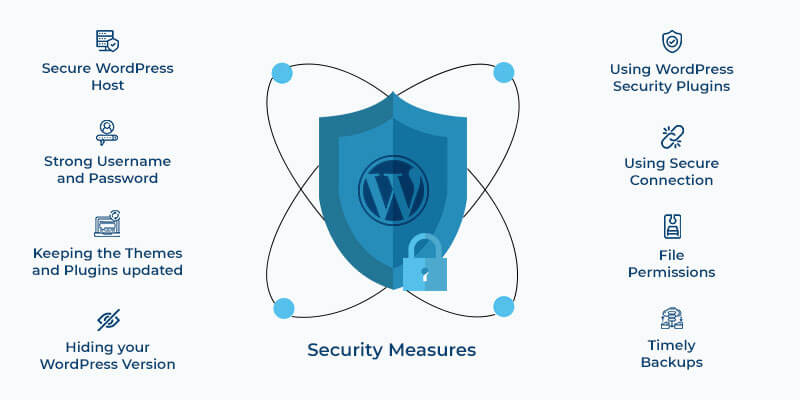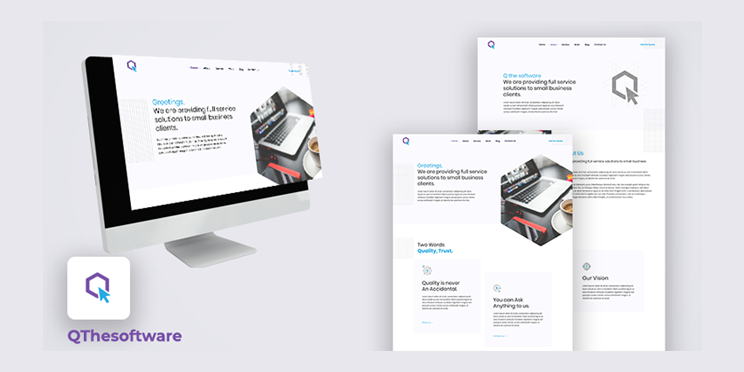If you are a website owner, you will agree with us when we say that WordPress security is a critical thing to look out for. Ignoring the security of WordPress website has cost a lot to the owners. As per reports, each week, around 20,000+ websites are blacklisted by Google for malware detection. If your business depends a lot on your website, then WordPress security must be your prime concern. You don’t have to be a WordPress developer to carry out the security measures. Without using much of the intricate coding languages, you can ensure that your WordPress website is secure.
When around 33% of all websites on the internet are powered by WordPress, and with various plugins and updates, it is quite likely to be affected with malware.
Security Loopholes and Their Solutions
Below is a list of the common loopholes while using WordPress development services and how they can be resolved:
1. Backdoors:
It is as per its name. Backdoor helps hackers in passing through hidden ways breaking the encryption to reach the WordPress website. Once there, it allows the hackers to create a mess on the host server by playing with multiple sites hosted by the server.
The easiest way to get rid of this is to run a scan with the help of online tools. Apart from this, using two-factor authentication, restricting accesses, and blocking IPs can help tackle the backdoors.
2. Brute-Force Login:
This vulnerability attacks weak passwords to access your WordPress website. An automated script runs to break these passwords. This is one of the most common problems as most of the website owners do not keep strong passwords.
The best way to go about brute force login attempts is to keep a strong password. Also, blocking IPs, two-step authentication and blocking the unauthorized accesses can be used to prevent this vulnerability.
3. Denial of Service:
The most dangerous of all is the denial of service. Hackers attack the websites through the errors in the code and mostly, the websites with outdated versions are prone to this attack. Although, the most updated versions are not solidly secured against DoS attacks.
There are other vulnerabilities like Malicious Redirects, Cross-Site Scripting and Pharma Hacks which are likely to attack a WordPress website.
Security Measures
Coming to the security part, it is not that tricky and it doesn’t require you to be a techie! Here is a detailed guide to walk you through the security measures for your WordPress website.

1. Selecting a Secure WordPress Host:
You may take the necessary measures from your end but having solid server security is a must. You should select a server host which you can trust as your business depends on it. The server that hosts your website should have a safe infrastructure to defend against the malware attacks.
The server should have an updated operating system and should be scanned regularly for vulnerabilities. It should be configured to use strong encryption for file transfer.
2. Strong Username and Password Protection:
You won’t believe if we tell you that one of the best ways to avoid any threats on your website is to use a strong username and password. It is also advisable to use different passwords for different websites. An easy way to store them is on your local database in an encrypted form.
While doing the installation, never agree to use the default ‘admin’ username. Create a unique username and delete the admin one if it exists.
3. Keeping the Themes and Plugins Updated:
Prevention is better than cure. This said, all those updates that you receive are there for a reason. Always keep your WordPress Plugins and Themes updated as they contain bug fixes and security measures.
Businesses often ignore the updates thinking that it will ruin their core WordPress. WordPress Developers know this and they don’t usually change the core functionalities but the updates usually contain security patches that can help tighten the security of your website apart from improved experience.
4. Hiding your WordPress Version:
Your WordPress version is visible in the header section of your website’s source code. It is better not to let your configuration out in the public. If the hackers get the wind up that your installation is not up to date, this becomes their entryway to mess up with your website.
Your WordPress version is also visible in the readme.html file which is present in the root directory. You can delete this as well to ensure extra security.
5. Using WordPress Security Plugins:
The WordPress website developers out there have made a plethora of security plugins which can be used to protect your websites. But keep one thing in mind, always use the updated plugins.
Plugins help you in many ways including creating strong passwords, ensuring a password reset when it expires, updating security keys, scanning, two-step authentication, blacklisting IPs, and such other tasks.
6. Using Secure Connection:
Always use a secure connection. Make sure that your server host is using SFTP (Secure File Transfer Protocol). This file transfer protocol is way more secure than the standard FTP.
Also, make sure that the router you use at your home location is correctly configured. If there are any glitches at that end, it becomes an easy task for the intruders to invade your information. Certain things that can be done to protect your router are:
- Protect your network from any outside attack by avoiding the use of remote VPN.
- Avoid the usage of the default IP range 192.168.1.1
- White-list the IP of your network so that only those with a password can access it.
Always take precaution while accessing your website in public areas!
7. File Permissions:
Striking the right balance for file permissions on your WordPress website development and the server is important. Too tight permissions can ruin the use of your Website functionalities and on the other hand, too loose file permissions can provide gateways to intruders.
- Read: This is allotted to those users who can just read the Files.
- Write: This is assigned to those users who can modify the file apart from Reading.
- Execute: This is assigned to those users who can run the scripts.
The same applies to Directory permissions as well. There are certain free plugins that can be used to scan the permissions on your website. Keep one thing in mind, set the permissions wisely.
8. Timely Backups:
No matter how many precautions you take to secure your website, it will never be safe to the core. So one thing that you must do is taking Backups at regular interval of time. In most cases, the hosting servers provide backups but if that isn’t the case, there are certain WordPress plugins and services that can be used to do the same.
There are several WordPress services like CodeGuard, VaultPress or BlogVault that can be used with a minimal fee each month. These services store your backup data on the cloud.
The WordPress backup plugins like WP Time Capsule, BackupBuddy, and BackUpWordPress etc help you to link your data directly to the third party cloud services.
Conclusion:
Your website represents what you do on the internet. It is your Brand Identity. If your visitors are not happy, it can cost you a lot. It is better to take the primary precautions that are in your hands like keeping strong passwords, updating the plugins and themes and using secure connections just to name a few to safe keep your business website. You can also implement the above measures to ensure extra security. And in case you are still worried, get in touch with WordPress development services like us to see what we can do to develop and protect your WordPress Website!




